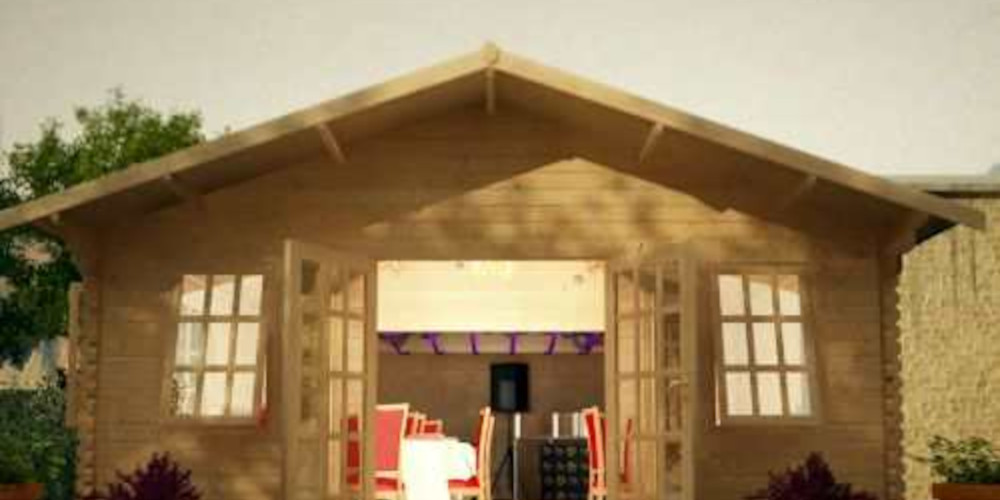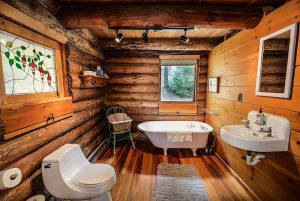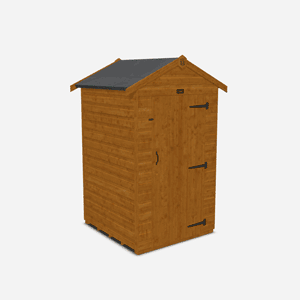Can I Live in My Shed or Log Cabin in the UK?
Published: 31/03/2021

More and more people in the UK are turning to garden buildings as an affordable way to own their own homes [1]. As you’re reading this, you could be thinking about something similar. Or you may be wondering whether it’s legal to turn your shed into a bedroom or lodge for when friends or family come to stay – and that’s a fair question. You may even want to know whether it’s possible to live in a log cabin in your parents’ garden, or whether you can live in a summerhouse in your garden during the warmer months. Or perhaps you want to create extra space for regular guests on your property and you’d like to know whether you need to worry about planning permission or building regulations. These are all questions we aim to answer in this blog post – so keep reading!
Liveable sheds: the potential advantages
Ignoring obvious practical and legal questions for a minute, let’s take a look at why you may want to create a shed bedroom or even convert your existing garden building into a permanent home:
- You can create more privacy for yourself or loved ones
- It’s less expensive than erecting even a low-budget house
- There’s less red tape – UK shed regulations aren’t as strict
- Council tax may be cheaper
- Sheds are quicker to build
- They’re easier to transport
- They’re widely available
These are just a few reasons why you may think that living in a shed is a good idea. Of all the points above, affordability is perhaps the greatest incentive for living in a shed – especially at time when the housing market continues to boom! Here’s why…
You’ll see the difference – and so will your bank balance!
Back in 2019, Channel 4’s Grand Designs stated the cost of self-building a ‘very small bungalow' on a budget would be around £87,500 [2]. Compare that to the price of the Aura, one of Tiger Shed’s premium log cabins, this year as an example. Add in the costs of adding modern conveniences (we’ll talk more about these later) and you’ll see your converted outhouse will set you back just a fraction of the cost of building or buying a conventional home. But despite all these advantages, there’s still a lot you need to take into account before converting your garden building into a liveable space…
Is it legal to live in a shed or even use it as an extra bedroom?

Surely living in a traditional garden shed is allowed if it’s on your own land – right? Unfortunately not. Standard garden sheds – even the best-made ones – are not designed to meet building regulations that govern the construction of houses and other living spaces. These include rules around planning permission, electricity supply, plumbing, heating, floor construction and more – all of which are largely absent (or at least not as strict) in UK shed regulations. Besides – can you imagine sleeping in a traditional outhouse shed in the dead of winter without proper insulation, heating or plumbing? So can we – and it doesn’t sound comfortable, clean or warm! Note: By contrast, log cabins with 28mm and 44mm wood are better insulated, so you would certainly be warmer in one of those! As a result, choosing a log cabin or summerhouse would be a more practical starting point than a standard 8x6 storage shed, for example.
And here’s the really good news…
There are legal ways to make living in an outhouse shed a reality:
Seek planning permission

Planning permission is important to consider if you or anyone else wants to live in your shed legally in the UK (or just stay there overnight from time to time). Here’s what’s you need to know…
Do I need planning permission for my live-in shed?
Do you have a shed with a pull-out sofa bed that friends or family use once every so often? Well, that’s not the same as using a shed as a regular or permanent living quarters. So, as the Homeowner’s Alliance states, if you or guests only wish to stay in your garden room occasionally, you may not require planning permission [3]. But if someone plans on sleeping in your shed regularly, or all the time, it is likely you’ll need to seek planning permission. The same principle applies to garages. To be sure whether or not you need planning permission, you should contact your local authority.
Permitted developments
Buildings that do not require planning permission are known as ‘permitted developments’. Under normal circumstances, sheds and other outbuildings are said to be permitted developments as long as they meet certain criteria. In general, to avoid the need for planning permission, your garden building should:
- take up 50% (or less) of the property
- have eaves that are 2.5 metres or less in height
- use a roof that is lower than four metres
- be one storey
- feature raised platforms that are less than 0.3 metres in height
- not be physically attached to the property
- not be within the grounds of a listed building
So can my live-in shed be a permitted development?
You may be wondering why the garden building you wish to convert into a shed bedroom, granny house, annexe or guest house can’t be considered a permitted development. After all, if your garden building meets all requirements in terms of height, size and distance from the original house, then you must be able to escape the need to seek planning permission from your local council, right? Not exactly. As we say in a previous post called “Do I Need Planning Permission for My Log Cabin?”, the law states that all separate living areas require planning permission. You can find more general information on planning permission for sheds elsewhere on the Tiger Sheds website. You’ll also see detailed technical information on the UK government’s gov.uk website [4].
The difference between planning permission & building regulations
It’s important to note that in the UK, planning permission and building regulations are not the same. With this in mind, you need to make sure you follow the rules governing both building regulations and planning permission.
Follow building regulations

To turn your outbuilding into a shed bedroom or general living space, you must obtain approval under UK building regulations [5]. As we alluded to earlier, there are many facets to these rules. These include the following (in no particular order) [6]:
- Electricity
- Water supply, plumbing and drainage
- Ventilation and damp proofing
- Heating, insulation and glazing (energy efficiency)
- Foundations and flooring
- Structural stability
- Accessibility
- Fire proofing
- Building materials
- The construction work itself
As you can see from the list above, there’s a lot more to creating a liveable garden space than erecting a garden toilet shed, for example. You need to think about plumbing – plus a whole lot more. When you complete the work to the correct standard, you must obtain a Certificate of Lawful Use (sometimes also called a Lawful Development Certificate [7]) for your live-in outhouse shed, log cabin or summerhouse. You’ll need to apply for Building Regulations approval if [8]:
- the floor is 30m² or more in volume
- you wish to install a toilet, sink or shower to the mains sewer
- the building is self-contained living accommodation
Adding modern conveniences to your liveable shed

The electrics, plumbing, insulation and other modern conveniences will either take you time to install, or add to the overall costs if you hire professionals to do this work for you. For more on the costs involved, visit the Checkatrade website [9].
Much more than just a garden toilet shed
In terms of adding plumbing to your garden building, it’s more complicated than adding waterworks to outdoor toilet sheds. Why? Because you may wish to add a shower or bath, for example. This, in turn, requires more space and a supply of hot water (unless of course you enjoy freezing cold showers every morning – brr!).
What it takes to get your shed ready to live in
If you put in a shower, you’ll also need a good extractor fan to expel moisture and avoid damp (not so important if you put in a bath). We show you how to ventilate your shed or log cabin elsewhere on the Tiger Sheds blog. With regard to insulation, our 44mm log cabins come with under-floor and under-roof options to help you stay cooler in summer and warmer in winter. For more information, take a look at our advice on how to insulate a shed. The Trusted Traders section of the Which? website is a great source of information on what it takes to install utilities in your shed, log cabin or summerhouse [10]. Of course, you'll also need electricity. For help with this, check out our tips on running power to a shed in the UK.
What about security?
While not vital in terms of your legal right to create beds in sheds, you'll no doubt want to keep your shed secure to protect yourself (or your guests) and your possessions. For help achieving this, read our step-by-step guide to shed security.
Remember council tax!
In addition to the rules and regulations mentioned above, you must also be aware that you may need to pay what some refer to as ‘granny annexe council tax’ [11]. Traditionally, a granny annexe was said to be a building associated with the main home – and they were meant to help older relatives stay close to family while also allowing them to live independently. If the granny flat is in use, the occupier must pay 50% of the cost of council tax for the main house. Get in touch with the relevant department at your local council for more information.
I’m not elderly – does the granny flat tax affect me?
Probably. If you own the main home or you’re related to the owner, you may also be entitled to a 50% discount on your council tax [12].
What size garden building is best to turn into a shed bedroom?

In theory, there are no size restrictions on your live-in shed. But in practice? That’s a different story. Let’s face it – you’ll need enough space for a bed and perhaps a toilet, shower, storage space and more. We’d recommend something like the Sigma – an attractive, natural-finished log cabin. With a range of sizes up to 20x20 feet, it features high 44mm interlocking planed and finished logs, as well as a veranda where you can rest after a hard day at work or in the garden during summer. It also boasts high-grade, pressure-treated floor joists to avoid damp, and heavy-duty mineral roofing felt as standard. In addition, toughened double glazing and 18ft guttering are optional extras. In addition, the Tiger Delta is available in sizes of up to 20x18 feet, while the Omega offers a whopping 30x18 feet of space. And like much of our range, you can customise your log cabin to make converting it into a liveable shed as pain-free as possible. As part of this bespoke shed design service, we can add internal walls and even an exterior door to give you the best starting point for your live-in garden building. We offer a wide range of log cabins, summerhouses and sheds that may be a suitable base for your live-in garden retreat. Explore our website to find out more.









